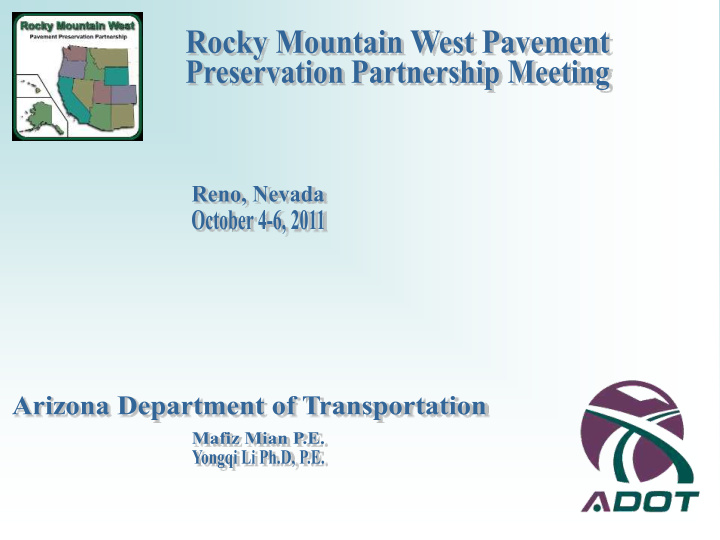



• Definitions • ADOT Pavement Preservation • Project Selection Process • Budget Micro-Surfacing • Expectations from RMWPPP • ADOT’s Pavement Preservation culture Chip Seal
Pavement Preservation • Proactive non-structural treatment Flush • Restores serviceability • Extends the service life Crack Seal
Pavement Rehabilitation • Structural enhancement Recycling Fleet • Extend the service life • Improve load carrying capacity Mill & Fill
Pavement Preservation Single Chip Seal Fog /Flush Micro- Friction Crack Seal Chip Seal Cinder Seal Slurry Seal Coat Surfacing Course
Used to: • Seal asphalt surface • Rejuvenate older surface • Reduce raveling and crack Flush/Fog Coat development Emulsion PASS QB, SS- 1 Newly Flushed
2 Types • 1) Single Chip Seal • 2) Single Chip Seal + Fog coat Chip Seal Binder • CRS-2P Used on • Low volume and rural roads Single Chip Seal + Flush
Used to: • Provide new wearing surface • Waterproof the surface Chip Seal + Flush • Seal small cracks • Reduce oxidation • Improve skid resistance Single Chip Seal + Flush
Binder • PASS CR (Chip Retention) Used for • Treating crack & moderate raveling Cinder Seal • Rural roads Cinder Chip Cinder Chip
Used For • Rut, crack & void filling / sealing Good Candidate • Applications on raveled, flushed and oxidized surfaces • Minor leveling • Urban and high volume roads • Good in curb and gutter sections to reduce clean-up operations Micro-Surfacing
Materials • Polymer modified, cationic, quick setting (mixing grade) emulsified asphalt (CQS-1hP) • A minimum of 4% polymer solids • Type III Micro-Surfacing is used
Used For • Sealing minor cracks and voids • Retarding raveling • Improving skid resistance and ride quality Slurry Seal • Roads with moderate traffic • Good in curb and gutter sections to reduce clean-up operations Materials • Polymer modified emulsified asphalt, QS-P or CQS-P • 2% minimum solid polymer non-latex Slurry Seal
Used to Seal crack width ¼ inch or greater Crack Seal Materials • Polymer Modified Asphalt Rubber Crack Sealant • Blotter (5%-10%) Crack Seal/Cleaning
Chip Seal on same section on SR 177 Crack Seal on SR 177 Minimum 3 months time gap between Crack Seal & 2 nd treatment
Advantages • Minimal generation of dust during construction • Resists rutting due to heavy traffic • No stone loss that might cause windshield damage • No binder runoff • Restores skid resistance • Treats raveled surfaces AR-ACFC • Improves ride quality • Low noise (AR-ACFC) • Drains water
Asphaltic Concrete Friction Course Asphalt Binder • PG 64-16 • 6% - 7% binder Asphalt Rubber ACFC Binder • PG Varies with temperature • AR-ACFC on Lane # 1 Crumb rubber gradation Type B • 20% crumb rubber of asphalt cement • 9% binder
Project is selected based on info obtained from: • Project request/scope from district • PMS- Project Management System • Road Review/inspection Road Review
Project Request/Scope from District
Pavement History from PMS
Distress Data from PMS
Traffic Data from PMS
Road Review Road Review Road inspection from headquarter Road Review
Budget Pavement Preservation Pavement Pavement Flush Preservation Rehabilitation $15 million $120 million Federal Funds are used for Pavement Rehabilitation all projects except for cinder seal and some flush Overlay projects .
Through RMWPPP we expect to share information, views & experience : - on issues Chip Seal + Flush - to resolve issues - to improve specifications - to improve construction method to make pavement preservation more cost effective & efficient. Newly Flushed
• Pavement Preservation(PP) is our permanent culture • Our dependency on PP has significantly increased Micro-Surfacing • Budget for PP is not enough • We are moving funds from pavement rehabilitation to PP • That way we are delaying pavement rehabilitation and extending the life of pavement & reducing the life cycle cost Crack Seal
Mill & Fill Recycling Cinder Seal
Recommend
More recommend